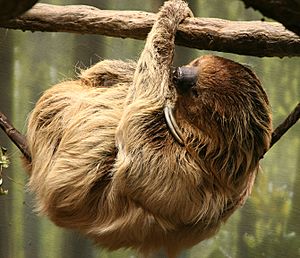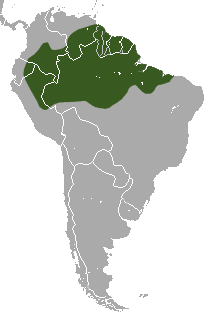Linnaeus's two-toed sloth facts for kids
Quick facts for kids Linnaeus's two-toed sloth |
|
|---|---|
 |
|
| Conservation status | |
| Scientific classification | |
 |
|
| Linnaeus's two-toed sloth range | |
| Synonyms | |
|
Bradypus didactylus Linnaeus, 1758 |
The Linnaeus's two-toed sloth (Choloepus didactylus) is a fascinating animal found in the rainforests of South America. It's also called the southern two-toed sloth or unau. These sloths live in countries like Venezuela, Suriname, Guyana, French Guiana, Colombia, Ecuador, Peru, and Brazil (north of the Amazon River). Recent studies even suggest they might live in Bolivia too!
Contents
What Makes Sloths Special?
Sloths are unique mammals. They belong to a group of animals called Pilosa, which also includes anteaters. This larger group, called Xenarthra, is known for having special backbones and often fewer teeth than other mammals.
Two Kinds of Sloths
There are two main types of modern sloths, named after how many toes they have on their front feet. These are the two-toed sloths and the three-toed sloths. The Linnaeus's two-toed sloth and Hoffmann's two-toed sloth are both part of the two-toed sloth family. This family also included some very large sloths that lived on the ground long ago, but they are now extinct.
How Does This Sloth Look?
Linnaeus's two-toed sloths are generally bigger than three-toed sloths. They have longer hair, larger eyes, and their front and back legs are almost the same length. Their ears, back feet, and head are usually larger too, but they have a shorter tail. Their arms are quite long, which helps them move through trees.
Their Unique Teeth
These sloths have fewer teeth than many other animals. They usually have four to five sets of teeth, including their canines. They don't have incisors (the front biting teeth). Their teeth are also special because they don't have enamel, which is the hard outer layer on human teeth. Instead, their teeth are made of two layers of dentin and keep growing throughout their lives.
Sloth Life in the Rainforest
The Linnaeus's two-toed sloth lives alone and is active mostly at night (this is called nocturnal). They spend almost all their time in trees (this is called arboreal), high up in the rainforest canopy.
What Do They Eat?
These sloths mainly eat leaves. It's a bit tricky for scientists to study their diet because sloths are nocturnal and their fur helps them blend in with the trees, making them hard to spot!
Slow and Steady Metabolism
Like other sloths, the Linnaeus's two-toed sloth has a very slow metabolism. This means their bodies use energy very slowly. They also digest their food for a long time because they have large digestive systems. This slow process helps them get the most nutrients from the leaves they eat.
Who Hunts the Sloth?
Even though sloths are good at hiding, they can become prey for other animals. Wild cats like the ocelot and jaguar hunt them. Large birds of prey, such as the harpy and crested eagles, also hunt sloths from above. Most of the time, sloths are caught when they come down to the ground to move between trees. Large snakes like anacondas are also known to hunt sloths, especially if the sloth is swimming. Yes, sloths can swim across rivers and creeks!
Gallery
See also
 In Spanish: Perezoso de dos dedos de Linnaeus para niños
In Spanish: Perezoso de dos dedos de Linnaeus para niños





